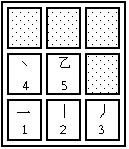
Wubihua is a simple method of inputting Chinese characters; the system uses only five keys, and the code for a single character is five keys long at most. Also, the code is based upon the written form of the character, not its pronunciation. The system requires minimal memorization and is therefore perfect for a person with the need to type Chinese but without the time to memorize a more complex system. Although Wubihua is not as efficient as some methods, it gets the job done.
The five keys on the Wubihua keyboard are 1, 2, 3, 4, and 5, and they represent the five basic strokes: horizontal, vertical, left-falling, right-falling, and the hook. In addition, the numeric keypad, not the numbers directly above the letters, are used.

A character's code consists of its first, second, third, fourth, and last stroke. If a character contains less than five strokes, then its code consists of every stroke, in order.
The vital concept to understand in order to successfully use Wubihua is stroke order, because the computer will not recognize a code entered in the wrong stroke order.
By to the rule introduced in Section 1, the code for 魏 (wei3) would consist of its first, second, third, fourth, and final strokes. These strokes, according to standard stroke order, are 丿, 一, 丨, 丿, and 丶. Thus, the code for 魏 is 31234. However, this code is not specific to 魏, since many characters have a similar stroke configuration. When the code is entered, the computer will show every character with that code, and the user will pick (by mouse click or use of the arrow keys) which character he wants. The characters on the list are usually organized by the frequency of their use; the most common characters are listed first.
In addition, as the code is being entered, the computer will show every character that corresponds to the code up to that point. Thus, while entering 魏, the computer produces the following lists of characters.

Observe how the computer eliminates characters as the code becomes more specific and lists the most commonly used characters first. 魏 is an uncommon character, so the computer requires a specific code to make the character appear higher on the list.
Since this text is geared for speakers of English at any level of Chinese proficiency, for those who may not have internalized stroke order, this section will present a list of the Wubihua codes of common roots/radicals. Thus, if a user cannot determine the stroke order of the first part or the last stroke of a character, he should refer to this list. It is organized by the number of strokes in the root/radical.

If still stumped, try entering the strokes in a different order; after all, there only are a certain number of possibilities.